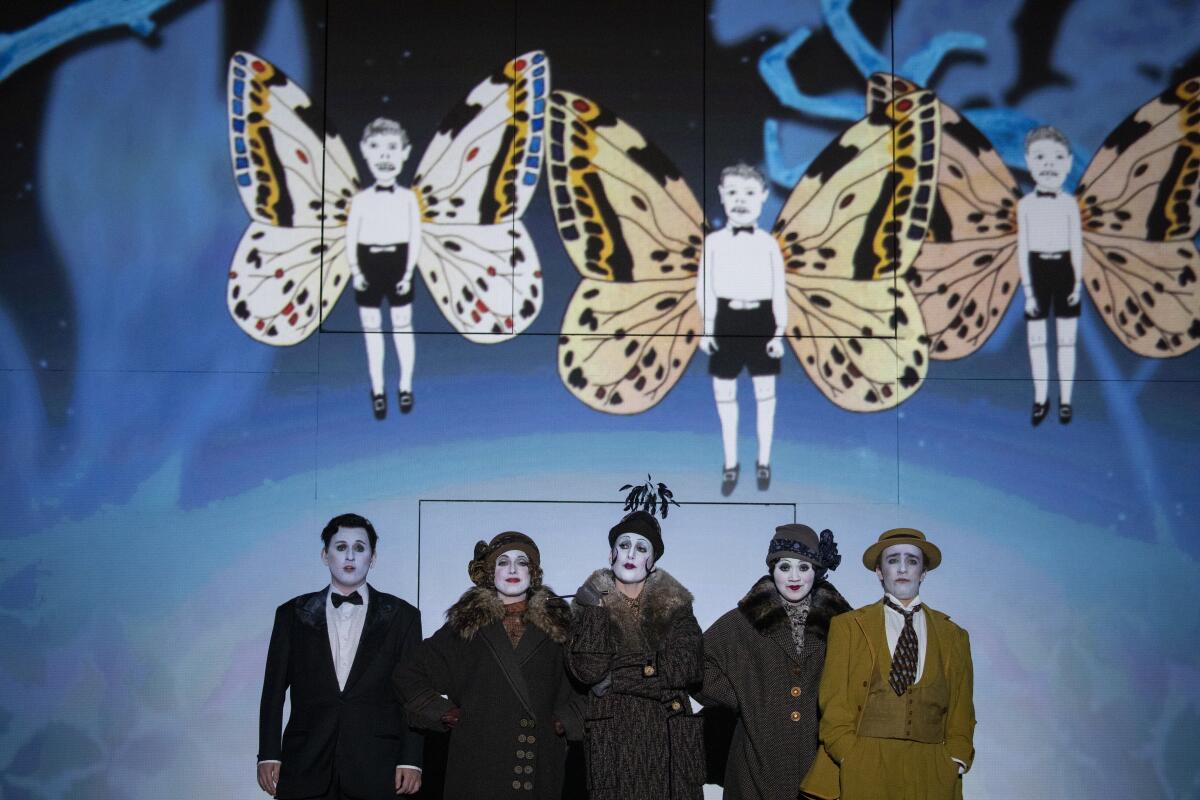Review: L.A. Opera brings back Barrie Kosky’s ‘Magic Flute’ with madcap cinematic style

Six years ago, Los Angeles Opera gave the U.S. premiere of the startling transformation of Mozart’s “The Magic Flute” into a live, not-so-silent silent movie. A hit at Barrie Kosky’s Komische Oper in Berlin, it was also the U.S. debut for the brilliantly provocative Australian director who Germany, and lately much of Europe, can’t get enough of.
As expected, “Flute” proved a sensation. L.A. Opera brought it back a couple years later with a different cast. It proved a sensation anew. Other American opera companies got wind, and the production has been making the rounds ever since. Last summer, it reached New York; this spring, Houston.
“Flute” returned once more to the Dorothy Chandler Pavilion on Saturday night. The cast, again, is mostly new. The conductor again is James Conlon, although the music director decamps next week to conduct a more conventionally updated “Flute” in Vienna, and Grant Gershon will replace him.
Yes, of course, this is once more a wonderful show, great for the holidays; great for opera lovers, newbies and the whole family; great for Mozart; great for reminding us of the wonders of silent cinema. It’s even great for PR mavens who might as well help themselves to adjectives above and below.
There is not a lot to say about this revival. For those who haven’t seen the production, simply let yourself be astonished. What worked before works still. There are a few improvements, and a few technical glitches on opening night aren’t likely to recur.
The main news is the company debuts of Zuzana Marková and Bogdan Volkov as the main pair of lovers, Pamina and Tamino. The Czech soprano had a rocky start vocally. She’s not exactly a lithe Mozartean. But the Louise Brooks costume suited her, and so did the second act. Her voice settled down, and she became a Pamina of rare depth, espousing angst and ecstasy with raw expression. The more unsparing the despair, the more gripping she was. The Russian tenor was another find, supple, lyrical and heroic, a romantic lead buoyant onstage.
The creators of the cinematic treatment, Suzanne Andrade, who is codirector of the production with Kosky, and animator Paul Barritt, treat the comic birdcatcher Papageno as a Buster Keaton figure, to which baritone Theo Hoffman marvelously added beguiling, high-kicking dance moves.
The cultish Sarastro, in fin-de-siècle top hat, represented pioneering French silent-film director Georges Méliès. Unlike singers in the earlier performances, Ildebrando D’Arcangelo brought a spiritual dimension to this first master of filmic magic. So Young Park, the spider-woman Queen of the Night in 2016, was again spectacular. Though masked, baritone Frederick Ballentine made an excellent meal of the lecherous Monostatos. There was no letdown with the assorted ladies, spirits, armored men, speaker and chorus.
So what’s not to like? The Dorothy Chandler Pavilion’s not to like. It’s too big for such a production. The projected translations, which would make better sense here as surtitles, are so far above the show that you can’t see both at the same time. Plus, they are so large that they take up far too much visual bandwidth. Maybe it’s good neck exercise, I don’t know. But I do know it’s not good opera.
The acoustics are ever a problem. With little in the way of stage properties for the sound to bounce off, most of the singers simply couldn’t project strongly enough to compete with the attention-devouring animated imagery. The orchestra in the pit might have been in a different room.
The company, though, has figured out what to do with the keyboard. Another innovation of the production is to remove the spoken dialogue (which is dated, with instances of what today can be heard as racially and sexually offensive) and replace it with silent film intertitles of a more modern and amusing sensibility.
They are accompanied by a pianist playing bits of two Mozart fantasies on a period keyboard. In earlier years, the fortepiano was loudly amplified. This time, the instrument sounded so natural that you couldn’t tell whether it was amplified or not.
I hope L.A. Opera will next figure out what to do with Kosky, with whom it thus far has a unique relationship for an American company. The fall season has been importantly, but gingerly, given over to the director. The opening production was Kosky’s vital “La Bohème.” But in between, rather than daring to present one of Kosky’s revelatory productions of a Broadway show (with operatic innovation and resources that are out of the question for Broadway), L.A. Opera hosted a vacuous road-show production of the vapid “Light in the Piazza” starring Renée Fleming — what you would expect to find in the kind of commercial theater that will take any damn thing that makes money.
“The Magic Flute,” moreover, is old news, in L.A. and Berlin, now that L.A. director Yuval Sharon has created something with a controversially millennial sensibility for the Berlin Staatsoper, just down the street from Komische. And it almost goes without saying that what we need to see is a true sampling of what’s on Kosky’s stage and on his mind right now.
'The Magic Flute’
Where: Dorothy Chandler Pavilion, 135 N. Grand Ave., L.A.
When: 7:30 p.m. Thursday and Saturday, 2 p.m. Dec. 1, 7:30 p.m. Dec. 12 and 2 p.m. Dec. 15.
Tickets: $54-$384 (subject to change)
Info: (213) 972-8001 or LAOpera.org
Running Time: 2 hours, 25 minutes (one intermission)
More to Read
The biggest entertainment stories
Get our big stories about Hollywood, film, television, music, arts, culture and more right in your inbox as soon as they publish.
You may occasionally receive promotional content from the Los Angeles Times.











